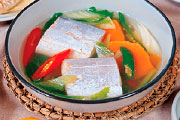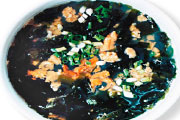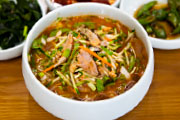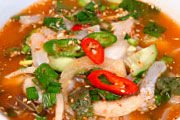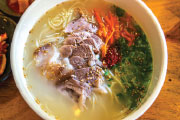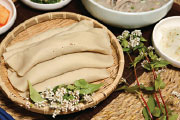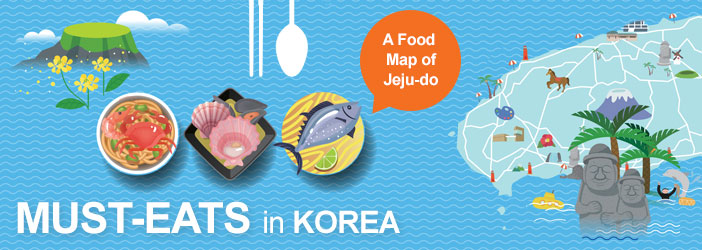-
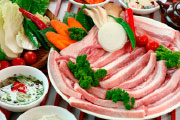
1 Heuk Dwaeji Gui (Black Pork BBQ)
Heuk dwaeji (black pig) is a native pig breed of Jeju. It has a black skin, a small body and grows relatively slowly. Since 1986, the Jeju Special SelfGoverning Provincial Livestock Institute has been in charge of the preservation and management of the black pig, which is less greasy in flavor while the fat part is known for being quite chewy. In Jeju, people eat black pork BBQ dipped in mel jeot or jari jeot, which gives the pork a more savory flavor.
-
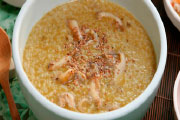
2 Jeonbokjuk (Abalone Porridge)
Abalone in Jeju live in strong sea currents which require them to move extensively in the sea and subsequently makes them chewy in texture. Also, due to the scarce supplies of rice, people in Jeju make porridge out of abalone. Indeed, there are various cooking methods which all use ground abalone innards and turns the dish yellow. Every coastal village in Jeju has a Haenyeo House which serves a bowl of porridge made from abalone freshly caught by the haenyeo.
-
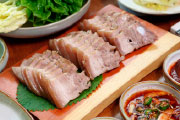
3 Dombe Gogi (Boiled Pork Served on a Wooden Cutting Board)
On Jeju Island, gogi (meat) refers to pork. Dombe gogi is pork boiled using a traditional Jeju recipe. In the Jeju language, dombe means a cutting board. Hence, dombe gogi is a pork dish, boiled as a large cut and then immediately sliced and served on a cutting board. Sometimes, the dish is eaten dipped in mel jeot. Unique to Jeju, the dombe traditional cutting board has long legs and looks more like a small table.
-
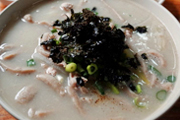
4 Kkwong Memil Kalguksu (Knife-Cut Buckwheat Noodle Soup with Pheasant)
Jeju is the biggest producer of buckwheat in Korea. Also, a substantial number of pheasants live within its middle-mountain area. Kkwong Memil Kalguksu is a traditional type of Jeju cuisine known as an invigorating meal, using both buckwheat and pheasant as its main ingredients. The noodles are wider, thicker and shorter than normal noodles that are cut with a knife while the pheasant broth has a lighter flavor than chicken stock and is less greasy than duck broth.
-
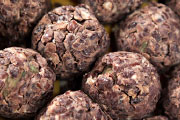
5 Omegi Tteok (Omegi Rice Cake)
Since it is almost impossible to grow rice in Jeju, the locals have farmed millet or barley instead. Omegi tteok is a type of rice cake made by kneading millet powder. Recently, glutinous rice or mugwort powder has been added, turning the dough a shade of green. The millet dough is stuffed with red bean paste, rolled into round balls and coated with mashed red bean, bean powder and nuts.
-
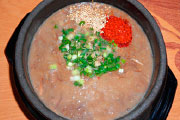
6 Gosari Yukgaejang (Spicy Beef Soup with Bracken)
In Jeju, there is a special season called gosari jangma (a rainy season from mid-April to earlyMay) which provides the perfect conditions for gosari (bracken) to grow. During that period, gosari flourishes everywhere in Jeju. Gosari yukgaejang is made by simmering pork, hand-torn Jeju-grown gosari and buckwheat powder for such a long time that the gosari becomes very soft and the soup becomes a thick, porridge-like texture. The tender flesh of the pork is easy to chew and swallow and theflavor of the soup is both spicy and refreshing.
-
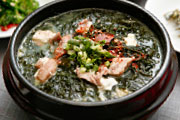
7 Mom Guk (Gulfweed Soup)
In the Jeju language, mom refers to mojaban (gulfweed). Mom guk has long been a customary dish at ceremonial occasions such as weddings or funerals in Jeju. Careful to not to throw away the pork broth after boiling the meat, the locals started adding pork innards to it and boiling them with mom, and this was the origin of mom guk. Similar to gosari yukgaejang, it is boiled with buckwheat powder and has a thick texture.
-
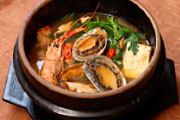
8 Haemul Ttukbaegi (Seafood Hot Pot)
Without doubt, seafood is what makes Jeju cuisine diverse. Among the many types of cuisine available, haemul ttukbaegi is a traditional seafood-based hot pot. It is made by boiling fresh in-season seafood and doenjang (fermented soybean paste) together. The hot pot features the delightfully savory flavor of the seafood broth, which is enhanced when mixed with doenjang. When it contains jeonbok (abalone), it is called Jeonbok Ttukbaegi; while with obunjagi (smaller abalone), it is Obunjagi Ttukbaegi.
-
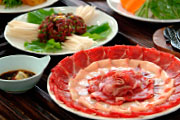
9 Mal Gogi (Horse Meat)
As an old Korean proverb states, “A human should be sent to Hanyang (old name for Seoul) and a horse to Jeju Island. “ The grassy plain within the middle-mountain area in Jeju has long been home to ranches. No wonder then that it gave birth to the tradition for eating horse meat. The recipes are various: boiled into sujebi (hand-torn noodle soup) with buckwheat noodles; eaten raw, as bulgogi (barbeque) or as shabu-shabu (hot pot with vegetables).









